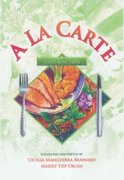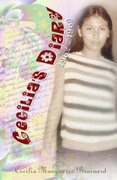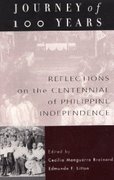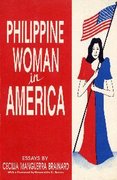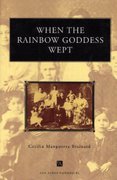I'm sharing a short story that's part of two books: Vigan and Other Stories, which is my third short story collection, and the collection of stories Growing Up Filipino: Stories for Young Adults
THE LAST MOON-GAME OF SUMMER
Cecilia Manguerra Brainard
Summer vacation is ending. While the moon is still large, we decide to play another moon-game, the last this summer. Jorge offers to go to his house to get buckets filled with water. As he's leaving, my cousin shouts, "Go help Jorge!" She’s been teasing me ever since our last moon-game when Jorge held my hand. I'm burning with humiliation, but Jorge simply smiles.
We're walking down the cobble-stoned street when a warm breeze blows stirring up the dry leaves, whipping my long hair around. I reach into my pocket for a rubber band to tie my hair back, confine all that wildness. I'm struggling with my unruly hair, when Jorge stops me. "It's nice like that," he says, taking away the rubber band from my hands. I feel embarrassed; I feel grateful. This attention makes me feel funny, and I start running. He runs after me, and together we race down the street.
Jorge's house is tall and dark, reminding me of an abandoned cemetery. The first floor is made of mossy bricks that need patching so badly. The upstairs is made of wood and the windows are the old-fashioned sliding kind, made of capiz. The white squares of capiz shells give off a strange luminescent glow.
The front doors were originally carriage doors, very wide, with a smaller door cut-out on the one side for people to use. There's an antique brass door knocker colored green from age, which amuses me greatly, I pound it several times until a servant opens the door.
It occurs to me that finally I'll see the inside of his house. It's two blocks away from our house, but until Jorge held my hand, I've dismissed this house as another decrepit mansion in Vigan. These past nights I've slipped away from my bedroom to head for the verandah. Standing on tiptoes, I stared across our neighbor's backyard to study the peak of Jorge's roof. I wondered where his bedroom was, how it looked, if he had a desk with books, or a side table, if he kept his books on the side table as I do mine. And I wondered if he was already asleep, or if he was reading, or if he was thinking of me as I was thinking of him.
When we’re in the house, Jorge's demeanor changes. He becomes solemn and serious, and I wonder if I played with the knocker too long, or if I said anything wrong. He whispers, "Papa is sick."
People in Vigan say his father is a descendant of a man from Canton, China who made a lot of money from cotton. But Jorge's father and his brothers fought over money and inheritance. His father drove away the brothers, and for that, God punished him and he developed a rare disease and has been bedridden for years.
I, too, assume a serious face. Jorge leads the way upstairs. There is a huge living room, which is dreadfully quiet. The windows are shut and the only source of light comes from double doors that are ajar. "Wait here," he says and he disappears behind the doors. The room is really quite dark and I feel frightened.
I see a huge framed picture of a Chinese man in Mandarin garb. The portrait hangs on the wall from a long cord attached to the ceiling. The man has a drooping Fu-Manchu moustache, his eyes are piercing, and his expression so stern that I think this man never laughed. I wonder if this is the man from Canton, Jorge’s ancestor. He reportedly came to Vigan in the late 1700s with a bundle of clothes and his abacus. With the cotton boom, he was able to build this house and marry a Spanish mestiza. His imperial glare makes me sit on the edge of a plantation chair and fold my hands on my lap. I look around at Viennese mirrors, marble-topped tables, and other portraits of people long dead. When Jorge returns, I point at the man's portrait, and he acknowledges he is a great-great-grandfather.
"I'll show you around," Jorge says. He leads me to another sitting room with a grand piano and harp. Pretending I'm a famous harpist, I stand next to the harp, my spine exaggeratedly erect, and with great flare I run my fingers over the strings. "Bravo!" Jorge says, clapping, "You look good doing that." I give a little curtsy and we both laugh.
"I'll show you something," he says. He takes me to the library, which has enclosed lawyer bookcases. He opens a case and pulls out a book. He lays it on a desk and opens it. I catch the title: The Discovery of the Moluccas and the Philippine Islands. Then he points out a date: 1708. I've never seen a book that old. "Can I touch it?" I ask, in great awe. He hands me the book. As I reach for it, our fingers touch. Flustered, I almost drop it.
I remember the night he held my hand. We were playing the moon-game on my aunt’s driveway. We had created a huge circle on the ground, using water. The “It” ran along the circumference and diameter, chasing the others who raced in and out of the circle. I stayed outside the circle, where I felt safe. "Come in," the others shouted in sing-song, "come in. Don’t be afraid," and reluctantly I ran into the circle. I was breathless with laughter and fear that I would be caught. The “It” singled me out in his pursuit. Like tentacles, his long arms waved toward me. My heart knocked against my ribs as I shrank away. The others shouted at me to run out of the circle, but I was afraid I’d get caught. I stood there, paralyzed. Jorge ran back into the circle, grabbed my hand, and pulled me out. He continued holding my hand. We were safe. I was safe.
"It's very old," I say, trying to hide my thoughts from him. I run my fingers over the old parchment paper. Avoiding his eyes, I fix my gaze on the book; I know he's watching me.
"Look at this drawing," he says, his hand brushing mine as he flips the book. He singles out an illustration of some natives next to a tree. He's standing close to me and I can feel the length of his body near mine. Our heads are so close together, I can feel his breath. We continue to pore over the book, but all I'm thinking about is Jorge next to me. I've spent nights dreaming something like this would happen; and now that it's happening all I can do is stare at an old book.
After we've scrutinized all the drawings, he leads me to a chapel full of antique ivory statues. The statues are dead-white with movable glass eyes and dark brown wigs made from human hair. I shiver and tell Jorge I don't like statues and dolls with real hair. He laughs.
"Do you want to see my room?" he asks. Without waiting for my answer, he leads me past the dining room to a room that must have been a smoking room in the past.
While the rest of the house has a dusty and moldy quality, Jorge's room is airy and light.The brightness comes from a wide window that opens out to the upstairs verandah. There's a bed, side tables, large desk, armoire, and cabinet. I walk past his bed and study an oil painting on the wall ― a landscape painting of women threshing rice "It's by Juan Luna," he says. I nod in recognition of the master painter's name. He tells me he used to have another room, beside his parents' bedroom, and that he moved into this room recently.
He sits on his bed and moves over, as if to make room for me. It's a four-poster bed with rich green velvet bedspread. I'm thinking we should hurry back to the park, but it feels right to be with Jorge. I sit beside him. We stare out at the verandah. There's a dry fountain in the middle, and scattered all around the tiled floor are Chinese dragon pots crammed with aloes and sword plants, tenacious plants that need little care.
All this time, we have been talking in whispers, but here in his room, his voice becomes normal again. He tells me about a sparrow who built her nest on the fountain, and how he watched her lay her eggs, how she sat on them until they hatched, took care of her babies until they were old enough to fly. "It was wonderful," he said, "Life just yards away."
And then I do something strange: I throw my head back and laugh.
"Why are you laughing?" he asks.
"It's silly, the bird with her babies, right in the middle of the verandah where everyone could see them," I reply, still laughing. I'm not making sense ― I know that ― and I wonder what's come over me. I look at Jorge wondering if he thinks I'm being foolish, but he takes a strand of my hair and pushes it back. He says, "I like to hear you laugh."
He lies back on his bed, closes his eyes. He's smiling; he appears content. He runs the palms of his hands on the bedspread as if rubbing the fur of an animal. "Of all the colors, I like green," he says. I remain seated although I'm tempted to curl up beside him, rest my head on his chest, listen to his heartbeat.
"Why do you like green?"
"It reminds me of Abra," he says. And he continues to tell me about the forest that he visited when he was seven. The caretaker of their house brought him to the mountaintop of Abra, where the forest was so thick there was hardly any sunlight. I have not been to Abra, but have heard of its remoteness, of its strangeness. Many years ago, the people there were headhunters; I have seen sketches of tattooed warriors holding human heads.
In this perpetual green, he looked around and felt God. "Do you believe in God?" he asks.
I pause, uncertain how to answer him. I hear running water and the rattling of pans from the kitchen. I know what he wants to hear. A part of me says I ought to tell him, yes, and in the Holy Trinity. Be done with all of that. Instead I say, "I'm an atheist." I say this softly, but with some defiance. I'm certain he will find me repulsive; he will never see me again.
He is not shocked. He watches me. "Why not?" There is curiosity in his voice, not judgement.
"I can't say; it's too much to explain."
"You go to St. Catherine's, and I've seen you in church."
"I do all that, but I just do them, I don't believe." I check his face and find a furrow between his brows.
Fingers pressed together as if in prayer, I add, "But I was a good Catholic before my father died. I said all my prayers and went to Mass." I describe the Sacred Heart at the landing of the stairs and Our Lady of Perpetual Succor in the hallway. I tell him about the holy cards I collect, some of which I keep in my missal. Before the First Friday of each month, the nuns herd us to the Redemptorist Church. "I learned to invent sins for some man I couldn't see eye to eye," I tell Jorge.
"Ah, I know about your father," he says, "the plane crash in Mount Manuggal. With President Magsaysay."
I fidget. I don't want to talk about that. It's too difficult to even think about all that. I hear sizzling and smell fried garlic. I didn't cry when the nun told me about the plane crash. I dug my nails deep into my flesh as I clenched my fist. Dear God, I prayed, let there be a mistake, let him have missed the flight. I made deals with God: I'd hear Mass everyday for the next month. But it didn't matter. Pieces of his body were sent to us in a closed coffin. I never saw his body before the burial, never saw what God did to him.
After the funeral, I used to play near the gate with my father's two police dogs.When a car drove by, the dogs barked and we raced to the gate, expecting my father.
"I didn't become an atheist just like that," I explain, snapping my fingers. "I didn't just say, now I no longer believe in God. Things just didn't make sense. The nuns talked about purgatory, which is temporary. Then there's hell, which is forever. Then there's another place called limbo, where unbaptized babies go. I see no justice in placing babies in such a place. Could God be so unfair?"
Jorge sits up. He strokes my hair back. I can feel the warmth from his hand. "You've been hurt," he says. "You're angry at God. One day you will realize that He loves you. And one day, I'll take you to Abra. It was there in Abra, that I knew God exists." Then he adds these words, softly, but I hear him: "I felt it inside, as surely as I know I love you."
He lifts my chin and I let him. My eyes are open; I do not know what to do. He presses his mouth to mine. I am surprised at how soft and moist a mouth is. It makes me think of that green forest in Abra, that mountaintop of Abra where he found God.
It makes me realize that even though we’ll go back and play the moon-game, and later my cousin and I will walk back to our house, and I’ll sleep in the same four-poster bed, and wake up in the morning and do the same things I’ve been doing all summer, that somehow things will never quite be the same ever again.
~end~

























